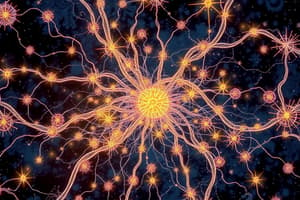Podcast
Questions and Answers
What happens to the areas left behind as the action potential spreads down the axon?
What happens to the areas left behind as the action potential spreads down the axon?
- They convert into neurotransmitters
- They initiate another action potential
- They return to their resting state (correct)
- They become depolarized
What is the role of the synapse in neuronal communication?
What is the role of the synapse in neuronal communication?
- It stores neurotransmitters until needed
- It conducts electrical impulses directly
- It physically connects neurons
- It allows chemical signals to pass between neurons (correct)
Which neuron releases neurotransmitters?
Which neuron releases neurotransmitters?
- Presynaptic neuron (correct)
- Postsynaptic neuron
- Sensory neuron
- Motor neuron
Which neurotransmitter is primarily associated with muscle action and memory?
Which neurotransmitter is primarily associated with muscle action and memory?
What effect do inhibitory neurotransmitters have on a neuron?
What effect do inhibitory neurotransmitters have on a neuron?
Which neurotransmitter is primarily linked to the reward system and addiction?
Which neurotransmitter is primarily linked to the reward system and addiction?
What is the function of reuptake in neurotransmission?
What is the function of reuptake in neurotransmission?
What is an effect of increased levels of GABA in the central nervous system?
What is an effect of increased levels of GABA in the central nervous system?
Which neurotransmitter is crucial for emotional arousal and metabolism of glucose?
Which neurotransmitter is crucial for emotional arousal and metabolism of glucose?
What is the primary role of excitatory neurotransmitters?
What is the primary role of excitatory neurotransmitters?
Flashcards are hidden until you start studying
Study Notes
Action Potential and Synapses
- Action potentials propagate along the axon while areas behind return to resting state.
- Synapses are pivotal for neuronal communication, allowing the passing of chemical signals.
- Neurons do not physically touch; neurotransmitters traverse the synaptic gap to transmit signals.
- Presynaptic neuron initiates the signal, while postsynaptic neuron receives it.
Neurotransmitter Release and Function
- Action potentials trigger terminal buttons at the axon’s end to release neurotransmitters into the synapse.
- Vesicles fuse with the presynaptic membrane, releasing their contents into the synaptic cleft.
- Neurotransmitters bind to receptors on the postsynaptic membrane, potentially eliciting an action in the postsynaptic cell, depending on whether an action potential is achieved.
- Unused neurotransmitters are typically reabsorbed by the presynaptic neuron via reuptake.
Types of Neurotransmitters
-
Excitatory Neurotransmitters
- Increase the probability of a neuron firing an action potential.
-
Inhibitory Neurotransmitters
- Decrease the likelihood of neuron firing an action potential.
-
Acetylcholine (ACh)
- Functions: muscle action, learning, attention, memory, REM sleep, emotion.
- Decreased levels associated with Alzheimer’s disease.
-
Dopamine (DA)
- Functions: movement, attention, memory, learning, emotion.
- Excess linked to schizophrenia; deficit related to Parkinson’s disease; significant role in addiction and reward pathways.
-
Endorphins
- Functions: mood regulation, pain relief, memory, learning, blood pressure, appetite, sexual activity.
- Therapeutic applications in pain management.
-
Epinephrine (Adrenaline)
- Functions: emotional arousal, memory storage, metabolism of glucose for energy release.
-
GABA (Gamma-Aminobutyric Acid)
- Functions: learning, anxiety regulation.
- Major inhibitory neurotransmitter in the central nervous system; tranquilizers like Valium enhance GABA's effects to reduce anxiety.
-
Glutamate
- Functions: learning, movement, memory.
- Key role in neural excitation within the central nervous system.
Studying That Suits You
Use AI to generate personalized quizzes and flashcards to suit your learning preferences.



